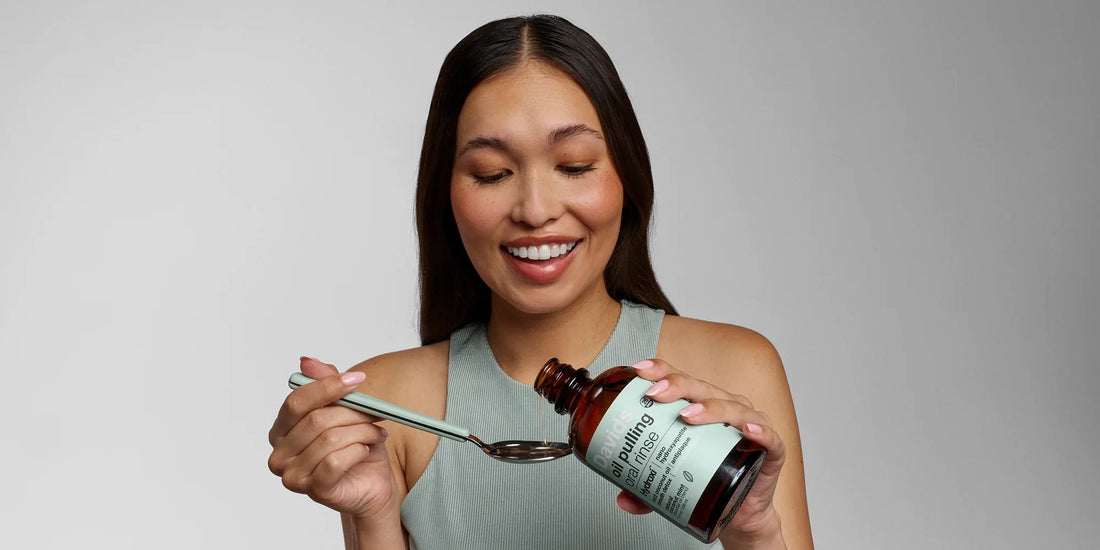PAP teeth whitening has recently gained some fame in the dental world.
For decades, teeth whitening has been dominated by the infamous hydrogen peroxide. But with many questions lingering about the safety of hydrogen peroxide, it might finally be time for a new hero whitening ingredient to claim its fame.
With so many different studies, stories, and posts about the safety and efficacy of PAP vs hydrogen peroxide, we’re here to set the record straight. There’s a reason so many countries have already banned hydrogen peroxide, and we think it’s important that you have all of this information before you start your next round of teeth whitening.
So, without further ado, let’s dive into the world of PAP teeth whitening. What is it? Is it safe? How does it compare to hydrogen peroxide? Don’t worry, we’re going to discuss all of it....because we want the absolute best for your pearly whites!
what is PAP teeth whitening?
Phthalimidoperoxycaproic acid (PAP) is a synthetic organic peroxy acid that activates bleaching. It’s gained a lot of popularity in the dental world, as research shows it’s just as effective as hydrogen peroxide at teeth whitening.
When it comes to teeth whitening, there are two approaches: physical and chemical. Physical whitening occurs when abrasive ingredients “exfoliate” the teeth and remove surface stains. Chemical whitening goes a bit deeper, removing surface stains and stains embedded beyond the surface. There are three main players in the world of chemical whitening.
- hydrogen peroxide: this famous ingredient has been used for decades in the world of dental care, home care, and beyond.
- carbamide peroxide: this chemical whitening agent contains a combination of hydrogen peroxide and carbamide (a naturally occurring molecule produced when protein is metabolized).
- phthalimidoperoxycaproic acid (PAP): a newer whitening agent that has proven as effective as hydrogen peroxide. PAP teeth whitening may be a safer option for your teeth.
All three of these ingredients oxidize stains by penetrating the enamel and breaking down the molecules beneath that “hold” the unwanted color. This leaves your teeth looking lighter, for longer.
PAP vs hydrogen peroxide + its safety and efficacy
Now, let’s investigate the main differences between PAP whitening and the famous hydrogen peroxide.
While all of these chemical ingredients are effective at whitening, peroxides tend to release free radicals as they work. Free radicals are unstable atoms that can damage your tissues and cells. This is why you may experience inflammation around your gums, tongue, and lining/roof of your mouth after prolonged use of hydrogen peroxide (especially if it’s highly concentrated). A 2016 study found that highly concentrated hydrogen peroxide and carbamide peroxide gels significantly decreased tooth surface hardness after prolonged use.
PAP whitening, on the other hand, does not release free radicals as it oxidizes stains. A 2019 study, 2021 study, and more studies have concluded that PAP teeth whitening is much safer and more reliable than hydrogen peroxide whitening. However, many news outlets will claim that PAP whitening is “not safe” because it hasn’t been on the market for long enough. While this may be true in the US, PAP teeth whitening has already made its mark in other countries since hydrogen peroxide has already been banned or restricted.
- In the EU, over-the-counter teeth products can only contain up to 0.1% hydrogen peroxide, which isn’t enough to noticeably whiten your teeth.
- In Japan, hydrogen peroxide is banned from cosmetic products since it’s considered unsafe for use.
- In Canada, hydrogen peroxide is subject to use, concentration, and/or manufacturing restrictions.
These countries turn to PAP teeth whitening as a safe and effective alternative. As a result, PAP whitening is not subject to the same bans and restrictions as hydrogen peroxide. Research also shows that adding hydroxyapatite can improve the safety and efficacy of PAP teeth whitening, as this enamel-strengthening ingredient helps to maintain a healthy pH and preserve your enamel as PAP does its job.
So, while some outlets claim that there’s not enough research to support the safety of PAP whitening, we must also consider that there is enough research to refute the safety of peroxides such as hydrogen peroxide and carbamide peroxide.
what’s the difference between PAP and PAP+?
You’ll notice that some companies market PAP+ teeth whitening. PAP+ is simply PAP with nano-hydroxyapatite (n-Ha) added to its formula.
As mentioned above, research shows that hydroxyapatite can help balance the pH of your mouth and remineralize your enamel while you administer PAP teeth whitening. This can help preserve the hardness and overall health of your teeth as you continue to lighten your pearly whites.
Hydroxyapatite already exists in your bones and enamel, so replenishing this mineral is very important for your oral health....especially when you’re whitening!
Our third-party lab tests show that our Sensitive+Whitening Nano-Hydroxyapatite Toothpaste outperformed leading competitors. On top of whitening your teeth, it effectively plugs exposed “tubules” that lead to your center nerve, remineralizing your enamel from the inside out and reducing sensitivity with every use. When you give your teeth a healthy dose of hydroxyapatite, the nanoparticles penetrate your enamel and fill the tiny holes, scrapes, and imperfections that exist, hardening your teeth and making them even more ready to handle treatments such as PAP teeth whitening.
Finally, daily teeth whitening that actually reverses sensitivity instead of causing it!







